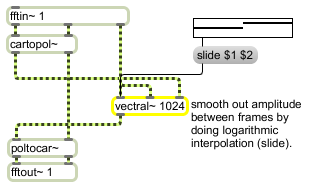Examples

vectral~ performs different types of smoothing between frames of vectored data (e.g. FFT signals)
Vector-based envelope follower
| Name | Type | Opt | Description |
|---|---|---|---|
| vector-size | int | opt | The argument is the vector size for the operation. It defaults to 512, but should be set appropriately for the size of the vectors you feed into the vectral~ object. |
| clear | Clears object's sample memory (in case of a blow-up). | |
| deltaclip | limits-of-change (2 floats) [list] |
In left inlet: The word , followed by two floats, limits the change in bins of successive vectors to the values given. This is equivalent to the time-domain deltaclip~ object. |
| rampsmooth | number-of-interpolating-frames [list] |
In left inlet: The word , followed by two ints, causes the vector to be smoothed in a linear fashion across successive frames. The arguments specify the number of frames to use to interpolate values in both directions. This is equivalent to the time-domain filtering done by the rampsmooth~ object. |
| signal | In left inlet: Accepts a sync signal for the output index of the vector. This is typically in the range of 0 to n-1 where n is the size of the vector. In middle inlet: A sync signal received in the middle inlet is used to synchronize the input index of the vector being processed. The sync signal will typically be in the range 0 to n-1 where n is the size of the vector. If the range of the sync signal is different than the output index, the incoming vector will be "bin-shifted" by the difference between the two signals. In right inlet: Signal data to be filtered. This will usually be frequency-domain information such as the output of an fft~ or fftin~ object. |
|
| size | vector-size [int] |
In left inlet: The word , followed by a number, sets the vector size for the operation. The default is 512. |
| slide | slide-denominator-coefficients (2 floats) [list] |
In left inlet: The word , followed by two floats, causes vectral~ to do logarithmic interpolation of successive vectors in a manner equivalent to the time-domain slide~ object. The two arguments determine the denominator coefficient for the amount of the slide. |

| Name | Description |
|---|---|
| cartopol | Cartesian to Polar coordinate conversion |
| cartopol~ | Signal Cartesian to Polar coordinate conversion |
| deltaclip~ | Limit changes in signal amplitude |
| fft~ | Fast Fourier transform |
| fftin~ | Input for a patcher loaded by pfft~ |
| fftinfo~ | Report information about a patcher loaded by pfft~ |
| fftout~ | Output for a patcher loaded by pfft~ |
| frameaccum~ | Compute "running phase" of successive phase deviation frames |
| framedelta~ | Compute phase deviation between successive FFT frames |
| ifft~ | Inverse fast Fourier transform |
| pfft~ | Spectral processing manager for patchers |
| poltocar | Polar to Cartesian coordinate conversion |
| poltocar~ | Signal Polar to Cartesian coordinate conversion |
| rampsmooth~ | Smooth an incoming signal |
| slide~ | Filter a signal logarithmically |
| MSP Tutorial 26: Frequency Domain Signal Processing with pfft~ | MSP Tutorial 26: Frequency Domain Signal Processing with pfft~ |